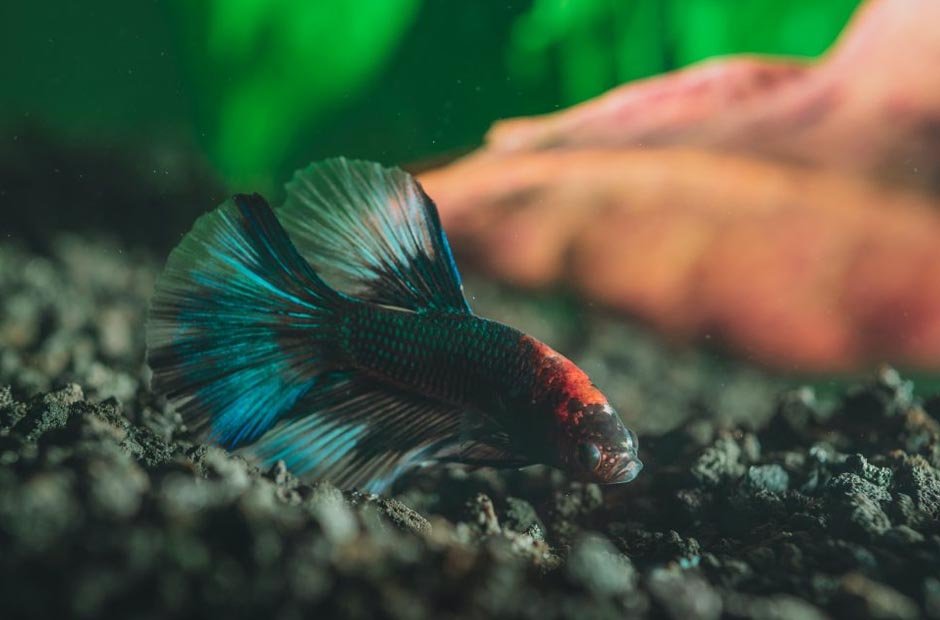If you’re a betta fish owner, you know how important it is to provide your fish with a healthy and comfortable living environment.
One of the most crucial components of a betta fish’s home is the substrate. With so many options available, choosing the best substrate for your betta fish can be overwhelming.
But don’t worry! In this article, we’ll dive into the world of betta fish substrates and help you make an informed decision on which one to choose.
Whether you’re a new betta fish owner or a seasoned pro, you’ll find valuable information here to help you provide the best possible environment for your fish.
So, let’s get started and learn how to choose the best substrate for your betta fish.
Table of Contents
#1. Go for a Natural Look
When choosing a substrate for your betta fish, it’s important to consider the aesthetic appeal of your tank. Going for a natural look can enhance your aquarium’s overall appearance while providing a more comfortable environment for your fish.
Natural substrates like sand or gravel mimic the bottom of a natural habitat for betta fish, such as a riverbed or pond. This can help your fish feel more at home and reduce stress.
When selecting a natural substrate, make sure to choose a size that is appropriate for your betta fish. Fine sand or small gravel is best, as larger pieces can be too rough and potentially harm your fish’s delicate fins.
Another benefit of a natural substrate is that it can provide a surface for beneficial bacteria to grow. These bacteria help to break down waste and maintain a healthy environment for your fish.
#2. Consider the Size of Your Tank
When choosing the best substrate for your Betta fish, it’s important to consider the size of your tank.
If you have a smaller tank, such as a 5-gallon tank, you may want to choose a finer substrate like sand or fine gravel that will make your tank look bigger.
However, if you have a larger tank, you can opt for a coarser substrate like pebbles or rocks to provide more surface area for beneficial bacteria to grow and aid in the nitrogen cycle.
It’s also important to consider any plants or decorations in your tank. A nutrient-rich substrate like aquasoil or fluorite may benefit their growth if you have live plants. If decorations or ornaments require a flat surface, a sand substrate may not be the best option, as it can shift and create uneven surfaces.
Ultimately, the size of your tank should be a major factor in your substrate choice. Choosing a substrate that will fit well in your tank and provide a comfortable environment for your Betta fish is important.
#3. Think About Your Betta’s Needs
When choosing the best substrate for your betta fish, it’s important to consider their specific needs. Betta fish prefer a soft substrate that won’t damage their delicate fins. Sand, smooth gravel, and planted substrates are good options.
It’s also important to consider the pH level and hardness of the substrate. Betta fish prefer a slightly acidic pH level and a soft substrate, so avoid substrates that will raise the pH level or make the water too hard.
Another factor to consider is the size of the substrate. Betta fish have delicate fins that can easily get caught in larger gravel or substrate. Choose a substrate that is small enough to avoid any potential harm to your betta.
Lastly, consider the cleanliness of the substrate. Betta fish are prone to developing fin rot and other bacterial infections, so choosing a substrate that is easy to clean and won’t create a buildup of harmful bacteria is important.
Sand and smooth gravel can be easily vacuumed, while planted substrates may require more maintenance.
#4. Consider the Type of Plants You’ll Have
When choosing a substrate for your betta fish tank, it’s important to consider the type of plants you plan to have. Some plants require a specific type of substrate to thrive, such as those that need nutrient-rich soil or a sandy substrate for their roots to anchor in.
If you plan to have live plants in your tank, choosing a substrate that can support their growth is important. Consider using a nutrient-rich soil substrate or a gravel substrate with added nutrients.
Additionally, some plants may require a specific pH level, so be sure to research your chosen plants’ needs before selecting a substrate.
#5. Don’t Forget About Maintenance
When choosing the best substrate for your betta fish tank, it’s important to consider maintenance. Some substrates may be easier to clean than others, so make sure to choose one that fits your cleaning routine.
Sand and gravel substrates may require more frequent cleaning to prevent debris buildup, while planted substrates may require additional maintenance to keep the plants healthy.
It’s also important to consider your filter type and how it will interact with the substrate. Some filters may not work well with certain substrates. For example, undergravel filters will cause issues if you choose aquasoil as your substrate.
So make sure to research compatibility before making a purchase.
Regular maintenance, such as water changes and substrate vacuuming, will also help keep your betta fish healthy and happy. Don’t forget to factor in these tasks when choosing your substrate.
Conclusion
In conclusion, choosing the right substrate for your betta fish is crucial for their overall health and happiness.
By considering factors like water chemistry, aesthetics, and ease of maintenance, you can find the perfect substrate to create a thriving environment for your pet.
So go ahead and give your betta the gift of a comfortable and beautiful home – they’ll thank you for it with their vibrant colors and energetic swims!










